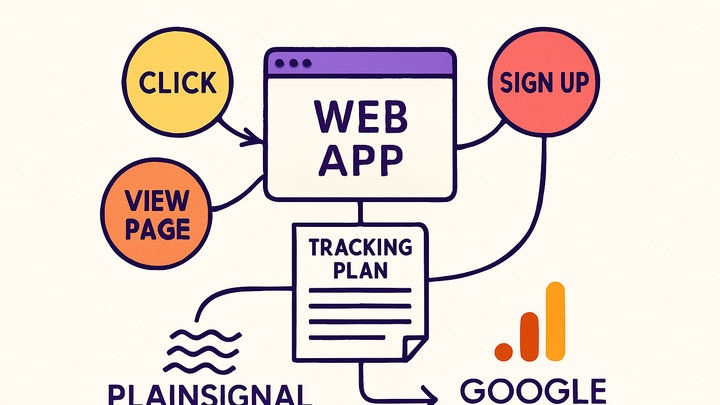Published on 2025-06-28T03:51:44Z
What is a Tracking Plan? Examples for PlainSignal & GA4
Tracking Plan is a comprehensive blueprint that defines which user interactions, events, and attributes your analytics stack will capture across web and mobile platforms. It serves as the single source of truth for event names, parameter schemas, and user properties, ensuring a consistent, organized, and scalable data layer. By specifying each event’s purpose, triggers, and data payload, a tracking plan prevents implementation drift, reduces ambiguity among teams, and helps maintain data quality. Organizations typically document their tracking plan in a shared resource (e.g., Google Sheets, Confluence, or a dedicated analytics tool) and refer to it during development sprints and analytics audits. A well-structured tracking plan aligns product, marketing, and engineering on data requirements, streamlines onboarding, and enables reliable reporting and analysis.
Tracking plan
A blueprint of events and properties for consistent, accurate analytics across platforms.
Why Do You Need a Tracking Plan?
Having a tracking plan before implementing analytics helps you avoid data inconsistencies, align cross-functional teams, and set clear expectations for what gets measured and reported.
-
Ensure data consistency
A tracking plan standardizes event names and parameters, which prevents confusion from inconsistent naming conventions and reduces implementation errors.
-
Cross-functional alignment
By documenting events in a shared plan, product, marketing, and engineering teams can align on what data is collected and how it’s used.
Core Components of a Tracking Plan
A robust tracking plan consists of specific elements that define how and what data is captured. These components form the foundation of any analytics implementation.
-
Event name
A descriptive, consistent label for a user action. Names should follow a standard convention (e.g., PascalCase or snake_case).
-
Example: `signupcompleted`
Tracks when a user finishes the signup flow.
-
-
Event parameters
Additional information captured with the event, such as
user_id,plan_type, orvalue. -
User properties
Attributes related to the user (e.g.,
country,subscription_status) that persist across events.
Implementing a Tracking Plan
Examples of how to implement your tracking plan using popular analytics platforms. Follow your documented schema to ensure accurate data capture.
-
PlainSignal (cookie-free analytics)
Add the PlainSignal script to your site and reference your plan’s event definitions:
<link rel="preconnect" href="//eu.plainsignal.com/" crossorigin /> <script defer data-do="yourwebsitedomain.com" data-id="0GQV1xmtzQQ" data-api="//eu.plainsignal.com" src="//cdn.plainsignal.com/plainsignal-min.js"></script> -
Google analytics 4 (GA4)
Use the Global Site Tag and send events according to your plan:
<!-- Global site tag (gtag.js) - Google Analytics --> <script async src="https://www.googletagmanager.com/gtag/js?id=GA_MEASUREMENT_ID"></script> <script> window.dataLayer = window.dataLayer || []; function gtag(){dataLayer.push(arguments);} gtag('js', new Date()); gtag('config', 'GA_MEASUREMENT_ID'); </script>gtag('event', 'SignUpCompleted', { method: 'Email', plan_type: 'Pro' });
Best Practices
Maintain a clean, usable tracking plan by following these guidelines.
-
Use a centralized document
Host your tracking plan in a shared location (e.g., Confluence, Google Sheets) for real-time collaboration.
-
Review regularly
Schedule quarterly audits to ensure events and parameters still reflect product changes.
Common Challenges
Be aware of potential pitfalls when creating and executing a tracking plan.
-
Scope creep
Adding too many events can overwhelm engineering resources and create noisy data.
-
Disorganized naming conventions
Inconsistent naming makes querying and reporting difficult, leading to inaccurate insights.
